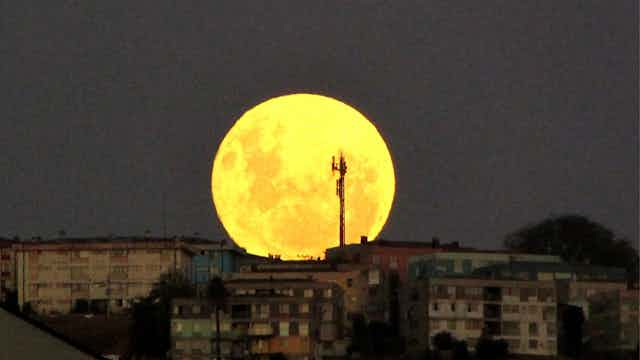This Sunday night, June 23, at precisely 9.33pm AEST, the full moon becomes a “supermoon” – an especially bright full moon.
This extra brightness occurs because the moon is closer to Earth than normal. The coincidence of a close moon when “full” only happens a few times a year but some supermoons are closer - and hence brighter - than others. This weekend’s supermoon is the closest, and most “super”, for 2013.
So, what time is best to see the supermoon?
Thanks to a curious psychological effect called the Moon Illusion, objects in the sky appear larger just above the horizon than when high in the sky. The moon will rise above the horizon at 5.07pm (AEST) in Melbourne just after the sun sets. So even though the moon is at it’s closest point four hours later, it will be most impressive as low on the horizon as possible.
Why does the moon come closer?

The moon moves around Earth in its orbit, tracing out a squashed circle called an ellipse. Unlike a circular line which is always the same distance from the centre, an ellipse is closer to the centre at certain times.
When closest, the moon will be 356,991km away from us but this is actually 50,000km closer than when it’s furthest away. Those 50,000km means the moon will be 14% wider (and 30% brighter). The change in size might be hard to notice but the brightness won’t be!
A possible side-effect of a closer moon is that it can make the tides higher. Fortunately, even at the closest point the tide will only be about one centimetre higher (although unusually shaped local shores might have tides as much as 15cm) so there is little risk of flooding.
As the moon moves in its month-long orbit around the Earth, the side we see will be lit by different amounts by the sun. We call this a change in the “phase” of the moon. When the sun, Earth and moon lie in a straight line, the moon reflects sunlight from its entire surface to us and we see it as a “full” moon.
A fortnight later the moon lies between the sun and Earth with the surface facing us in shadow, we call this a “new” moon.
The Moon Illusion
The illusion is most obvious for the moon but also happens for any distant object in the sky (it would happen for the sun but staring at this isn’t a good idea). This effect has been studied for thousands of years with Aristotle writing about it in 350BCE.
To check this is an illusion – and not the moon shrinking as it moves in the sky – hold out your thumb at arms length and cover the moon when it’s just risen. Note how much your thumb blocks. Then repeat this when the moon is high in the sky. You should find that the same amount of thumb covers the moon, so it really isn’t changing in size.
Astronomers and psychologists are still at odds about what’s behind the illusion. One theory is distant buildings can act as a reference object, making the moon seem larger (also known as an Ebbinghaus Illusion). Yet pilots see the Moon Illusion when flying with only shapeless clouds below, removing any reference point. Another idea relies on our brain being tricked by distant objects seemingly coming together in a Ponzo Illusion.
But most suggest it is inbuilt in how humans see the world: through evolution, our brains are hardwired to pay more attention to those things in front of us than above (it’s likely that fewer cavemen were attacked by birds than by wolves). So objects in front of us appear larger in our attention.
It’s important to note that if you look at the rising moon with a tilted head (or even upside down!) the illusion isn’t quite as unnaturally large. This might look a little strange to other people but you could get away with it under the guise of the urban legend that more people act crazy under a full moon.
Check the time for your local moonrise here and details about future supermoons here.

